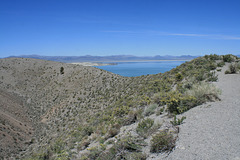Panum Crater, just south of Mono Lake, is the youngest and northernmost of the Inyo-Mono Domes (or Craters). These are a distinctive set of small domelike volcanoes nearly all consisting of rhyolite, a lava with a high silica (silicon dioxide) content. Molten rhyolite has a consistency about like toothpaste, and because of this high viscosity it tends to form glass when it's cooled quickly--that is, it forms volcanic glass or obsidian. Nearly all obsidians have a rhyolite composition.
The eruption starts with a fountain of ash ("tephra"), of which some falls out in a ring around the vent while the rest is dispersed. Later rhyolite magma is extruded. Since it's so viscous it doesn't flow far, but builds up in the center of the vent to form a dome. The rhyolite also typically forms massive obsidian around the edges because it cools more quickly there. This can be seen at the dome in Panum Crater.
Uniquely, Panum Crater is so geologically young, erupting about when the Black Death was ravaging Europe, that the tephra ring is preserved. Being just loose material, it erodes away geologically quickly, and no rings are left around the older domes.
Panum Crater, just south of Mono Lake, is the youngest and northernmost of the Inyo-Mono Domes (or Craters). These are a distinctive set of small domelike volcanoes nearly all consisting of rhyolite, a lava with a high silica (silicon dioxide) content. Molten rhyolite has a consistency about like toothpaste, and because of this high viscosity it tends to form glass when it's cooled quickly--that …
(read more)



















